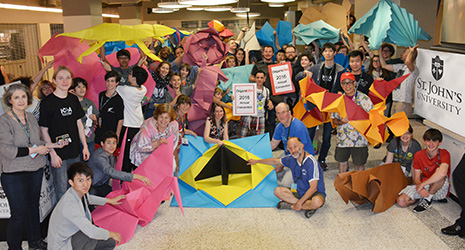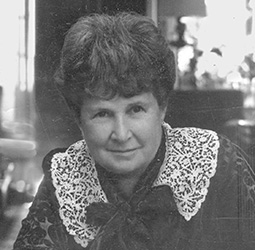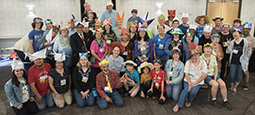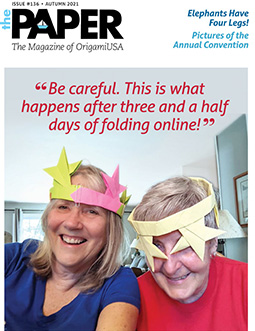INDEX
- English
- 日本語

People enjoying origami at an OrigamiUSA event - English
- 日本語

World Origami Days 2021 flyer

Lillian Oppenheimer, who helped to popularize origami in the United States beginning in the 1950s 
OrigamiUSA event participants wearing their origami creations 
Cover of an OrigamiUSA magazine
December 2021
“Origami Is for Anyone, Anywhere, Any Time!”: The History and Activities of OrigamiUSA

An American woman who encountered origami became fascinated by the artistry of paper folding and developed various pioneering activities to promote it. Her name is Lillian Oppenheimer, and her efforts ultimately led to the establishment of “OrigamiUSA,” a non-profit organization which carries out educational and promotional activities. Today, OrigamiUSA collaborates with origami organizations around the world, including those in the United States, Canada, and South America. Here, we present some of the history and activities of OrigamiUSA.

OrigamiUSA (OUSA) is one of the largest origami organizations in the world, with an administrative base at the American Museum of Natural History in New York City. The organization’s mission is to “share the joy of paperfolding,” and today over 1,700 origami enthusiasts participate in more than 100 local origami groups across the United States and around the world. Origami was previously referred to by its English translation “paper folding,” but it was OrigamiUSA that contributed to the popularization of the Japanese word “origami” worldwide.
“The establishment of OrigamiUSA stemmed from the pioneering activities of the American Lillian Oppenheimer (1898–1992). She became charmed by paper folding in around 1953 when she learned how to fold the ‘flapping bird,’ an origami piece which flaps its wings when you pull its tail, and then started to promote paper folding in earnest,” says Matsuura Eiko, who has researched the subject of origami.*

Oppenheimer came to feel even more strongly that origami is a cultural activity which adults can enjoy when she read Paper Magic: The Art of Paper Folding (1956) by the British magician and author Robert Harbin, Matsuura explains.
She sent a letter to Harbin and traveled to the United Kingdom to meet him. Encouraged by this encounter, she started to correspond with origami artists around the world, including the “father of modern origami,” Yoshizawa Akira (1911–2005), a Japanese artist who was considered the foremost authority on creative origami, and her activities became international.
Working from the Origami Center which she founded in 1958, Oppenheimer acquired knowledge, techniques and materials through her correspondence with people involved in origami around the world and sought to disseminate information about origami, such as by publishing books. In 1959, Oppenheimer went on a world tour and met with Yoshizawa in Japan in April of that year, an event which was covered in the Japanese media.

Eventually, albeit after she had passed away, the work of Oppenheimer and her fellow origami aficionados bore fruit, with the growing popularity of origami across the United States resulting in the founding of OrigamiUSA, which continues to this day.
OrigamiUSA has promoted origami in many different ways, including distributing newsletters, publishing books, and holding workshops. It also has started to hold online-workshops recently. At the American Museum of Natural History, OrigamiUSA has established the world’s largest specialized origami library, created from Oppenheimer’s collection. Márcio Hideshi Noguchi, a second-generation Japanese-Brazilian who also served as the chairman of the OrigamiUSA board, says, “I myself learnt origami from my mother, but the activities of OrigamiUSA are really important for giving Americans without that tradition a chance to encounter origami.”

OrigamiUSA’s biggest event is the annual convention held in New York each June. The event features the latest, most ambitious works produced by members of affiliated groups in the United States and around the world.
“Works on a wide array of themes are presented at the event, including real animals and plants, imaginary animals, and geometric forms. Many prominent artists also take part, but works aren’t judged or ranked—pieces by unknown amateurs are exhibited alongside those by celebrated artists. This is the unique spirit of OrigamiUSA,” says Marcio with a smile.
Marcio’s favorite quote is from Michael Shall (1949–1995), one of the co-founders of OrigamiUSA and someone who dedicated himself to promoting origami. Shall said, “Origami is for anyone, anywhere, any time!” This is also the official motto of OrigamiUSA. Marcio explains that the words of the motto ring true whenever his work takes him to different parts of the world and he starts doing origami, each time experiencing a powerful sense of opening up a circle of communication that transcends differences of race, language and culture. “The surprise felt at being able to create an unexpected form, simply by folding a single sheet of paper, is universal,” he says.
OrigamiUSA and Japanese origami organizations and artists have kept up their communication ever since Oppenheimer first began corresponding with them. As a testament to this, OrigamiUSA has designated the period from Oppenheimer’s birthday on October 24 to Origami Day in Japan on November 11 as “World Origami Days.”** Along with the Convention in June, a variety of events will be held during this period in the United States and other countries where OrigamiUSA groups are active.
Inheriting the spirit of Oppenheimer and her fellow origami practitioners, these two events serve to connect origami enthusiasts around the globe and to spread the joy of origami across the world.
* Thi Matsuura Eiko, The Birth of “Origami”−Focusing on the dissemination pursuits of Lillian Oppenheimer−, Toyo University Repository Academic Resources, Vol. 57 2021 pp.199-214
** Origami Day was designated by the Nippon Origami Association (NOA) in 1980. November 11 was selected for two reasons. Firstly, the 11th day of the 11th month contains four number 1’s. The number 1 is likened to one side of a square, so together these form four sides of a square sheet of origami paper. Secondly, November 11 is World Peace Day (the day the armistice of World War I was signed), and origami shares much in common with the spirit of wishing for peace.

